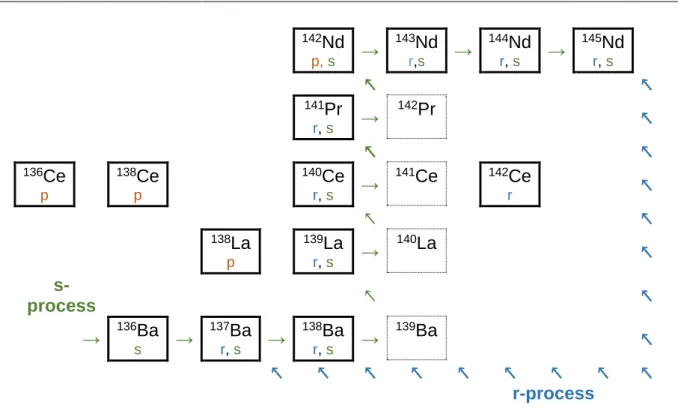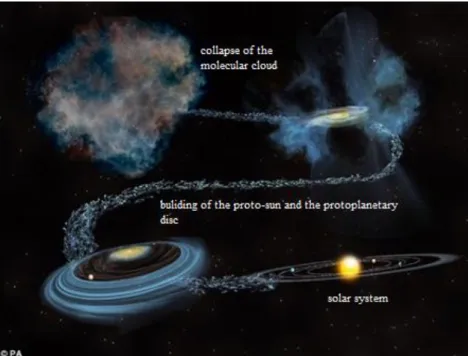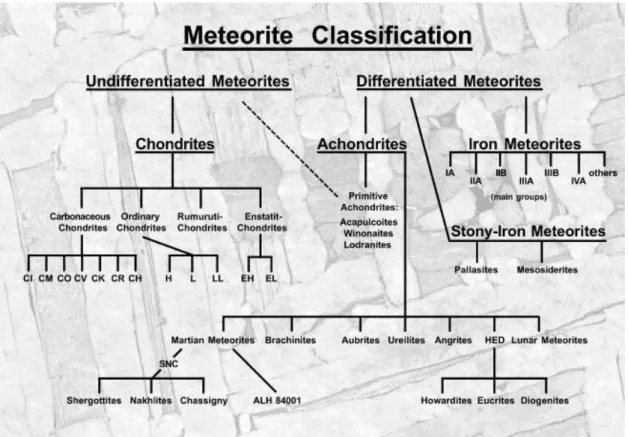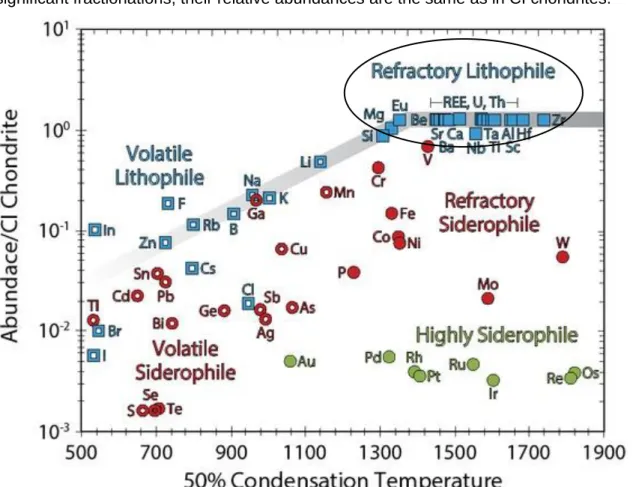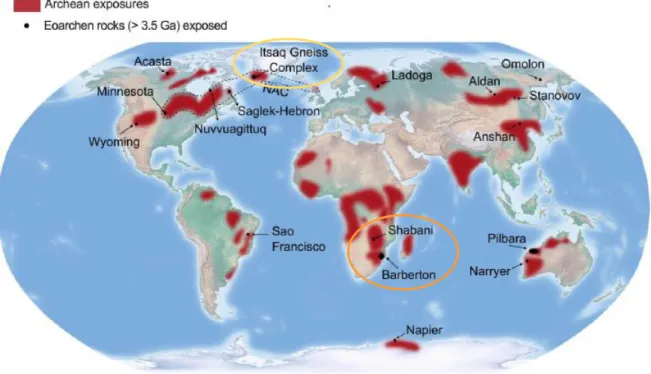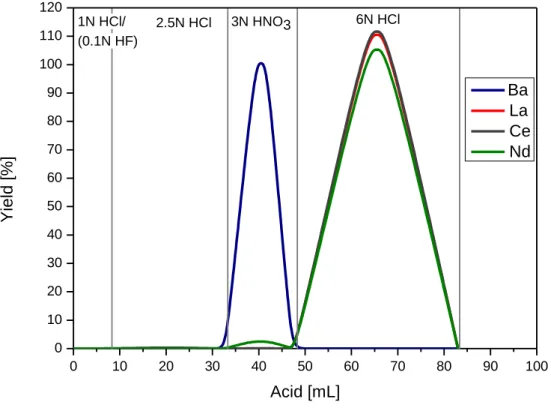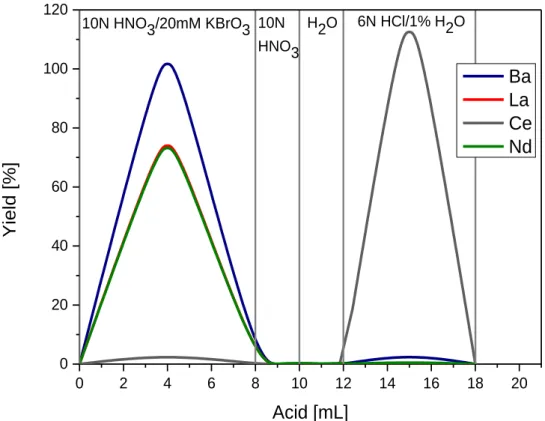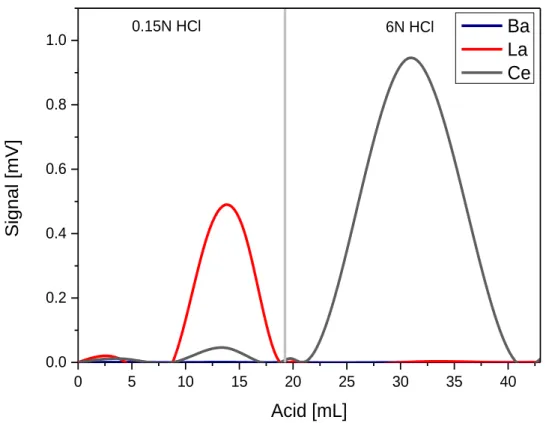138 La- 138 Ce systematics in terrestrial samples and chondrites
Inaugural-Dissertation zur
Erlangung des Doktorgrades
der Mathematisch-Naturwissenschaftlichen Fakultät der Universität zu Köln
vorgelegt von
Christiane Schnabel
aus Wagna
Köln, 2019
Gutachter: Prof. Dr. Carsten Münker PD. Dr. Erik Strub
Tag der mündlichen Prüfung: 16.01.2020
1
Table of content
Abstract ... 3
Kurzzusammenfassung ... 5
1. Chapter 1 ... 7
Introduction ... 7
1.1. Aim of this study and overview of the chapters ... 7
1.2. The origin of the elements ... 7
1.3. Primordial nucleosynthesis ... 7
1.4. Stellar nucleosynthesis ... 9
1.5. Nucleosynthesis of heavier elements ...10
1.6. Consequences of nucleosynthesis for Ce ...11
1.7. Evolution of the solar system ...13
1.8. Meteorites ...13
1.9. Chondrite classes ...14
1.10. The Geochemistry of Lanthanum and Cerium ...16
1.11. The
138La-
138Ce Geochronometer ...17
1.12. Chondritic Earth: CHUR value ...19
1.13. Non-chondritic Earth ...22
1.14. Earth’s oldest rocks ...24
1.15. Crust-Mantle Models ...26
2. Chapter 2 ...31
La–Ce isotope measurements by multicollector- ICPMS ...31
2.1. Introduction ...31
2.2. Analytical Protocols ...33
2.3. Reagents and sample digestion procedures. ...33
2.4. Chemical separation procedures for Cerium isotope measurements (Ce-IC) and La- Ce concentration measurements (La-Ce-ID). ...34
2.5. Preparation of a mixed La-Ce isotope tracer ...37
2.6. La-Ce measurements by MC-ICP-MS ...39
2.7. Ce-IC Measurements. ...39
2.8. La/Ce-isotope dilution (ID) measurements ...43
2.9. Cerium isotope compositions of synthetic reference materials and rock standards.44 2.10. Synthetic Reference Materials (JMC-304, Cologne and Mainz-AMES batches). .44 2.11. Recalculation relative to the chondritic uniform reservoir (CHUR) value. ...48
2.12. Cerium isotope composition and La-Ce concentration measurements for geological reference materials. ...48
2.13. Conclusions ...54
3. Chapter 3 ...56
The Ce isotope composition and La/Ce value of CHUR ...56
2
3.1. Introduction ...56
3.1.1. Previous CHUR estimates for the
138La–
138Ce system and data comparison ...57
3.2. Analytical methods and samples ...62
3.2.1. Meteorite samples analyzed in this study ...62
3.2.2. Sample preparation and ion-exchange chromatography ...63
3.2.3. Mass spectrometry ...64
3.3. Results ...65
3.3.1. Selection of data for the CHUR determination ...69
3.4. Discussion ...71
3.4.1. Cerium isotope data and standard reference materials ...71
3.4.2. Lanthanum-Cerium concentration data ...72
3.4.3. Calculation of the mean
138Ce/
136Ce and
138La/
136Ce CHUR values ...76
3.4.4. Implications for terrestrial La-Ce systematics ...80
3.5. Conclusions...83
4. Chapter 4 ...85
Combined
138La-
138Ce,
147Sm-
143Nd and
176Lu-
176Hf isotope systematics in early Archean rocks from southern West Greenland and South Africa ...85
4.1. Introduction ...85
4.2. Geological Overview ...86
4.3. Analytical methods ...90
4.3.1. Sample preparation and ion-exchange chromatography ...90
4.3.2. Mass spectrometry ...91
4.4. Results ...92
4.4.1. Present day ε
143Nd(0)/ε
176Hf(0) and ε
138Ce(0) values ...96
4.4.2. ε
143Nd(t)/ε
176Hf(t) and ε
138Ce(t) values ...98
4.5. Discussion ... 102
4.5.1. Influence of alteration and metamorphism on the La-Ce isotope composition ... 102
4.5.2. Cerium anomalies ... 105
4.5.3. Effects of Sediment recycling on source compositions ... 107
4.5.4.
138La-
138Ce CHUR value ... 107
4.6. Conclusion ... 112
References ... 114
Danksagung ... 129
Appendix ... 130
4.7. Appendix A ... 130
4.8. Appendix B ... 133
Erklärung ... 137
3
Abstract
The long-lived
138La-
138Ce decay system (half-life 1.02 x 10
11a) is a potentially useful tool to study the behavior of the light rare earth elements (LREE) and to unravel information about the timing of geological processes and about the interaction of geological reservoirs on Earth.
In earth sciences, the
138La-
138Ce geochronometer can therefore complement information from the more popular long-lived
147Sm-
143Nd and
176Lu-
176Hf isotope systems.
This thesis presents a new analytical protocol for the application of the
138La-
138Ce geochronometer. An efficient three-step ion-chromatography procedure allows to separate La and Ce in rock matrices from other rare earth elements (REE) and from interfering Ba.
Additionally, an analytical protocol was developed to measure Ce isotope compositions and La and Ce concentrations by MC-ICP-MS. For the first time, all stable Ce isotopes (
136Ce,
138
Ce,
140Ce and
142Ce) were measured simultaneously by employing a 10
10Ω amplifier for the most abundant isotope
140Ce. Because the traditionally used JMC-304 Ce reference material is not commercially available anymore, a new reference material was prepared from AMES laboratory Ce metal (Cologne-AMES). In order to compare the new material with the previously reported isotopic composition of AMES material prepared at Mainz (Mainz-AMES), Cologne- AMES and JMC-304 were measured relative to each other in one analytical session.
Additionally, for La and Ce concentration measurements by MC-ICP-MS, an isotope tracer enriched in
138La and
142Ce was prepared and calibrated against high purity AMES metals. The new protocols were applied to determine the variations of Ce isotope compositions and La and Ce concentrations of geochemical reference materials: BCR-1, BCR-2, BHVO-2, JR-1, JA-2, JB-1b, JB-3, JG-1, JR-1, AGV-1 and one in-house La Palma basalt standard (LP1).
Subsequently, the protocols were used to determine the important CHUR reference parameter (chondritic uniform reservoir) for the
138La-
138Ce isotope system, which is defined by the present-day chondritic
138La/
136Ce and
138Ce/
136Ce values. This parameter is still poorly determined for the
138La-
138Ce decay system but highly significant, once age-corrected initial Ce isotope ratios are calculated for older samples or for the determination of the Ce-Nd mantle array. Therefore, La and Ce concentration as well as Ce isotope measurements were performed combined with
147Sm-
143Nd measurements from the same aliquots for 22 different meteorites including carbonaceous chondrites (CM, CK, CV and CO), ordinary chondrites (H, L and LL), and enstatite chondrites (EL and EH). After a detailed data evaluation of previous studies by Bellot et al. (2015) and Willig and Stracke (2019), the recommended chondritic
138
Ce/
136Ce mean value is 1.33686±3 (2 s.e., n=18) and
138La/
136Ce mean value is 0.1868±40 (2 s.e., n=33).
Due to the ongoing debate, which group and petrological type of chondrites reflect the building
blocks of the Earth
138La/
136Ce and
138Ce/
136Ce mean values of carbonaceous and non-
4 carbonaceous chondrites are determined. The recommended carbonaceous chondritic
138
Ce/
136Ce mean value is 1.33684±2 (2 s.e., n=10) and and
138La/
136Ce mean value is 0.1946±43 (2 s.e., n=14). The non-carbonaceous chondritic
138Ce/
136Ce mean value is 1.33689±4 (2 s.e., n=17)
138La/
136Ce mean value is 0.1823±46 (2 s.e., n=17)
The application of the
138La-
138Ce isotope system in combination with the
147Sm-
143Nd isotope system is used to define the Ce-Nd mantle array comprising of mid-ocean ridge basalts (MORBs) and oceanic island basalts (OIBs). The chondritic
138Ce/
136Ce mean value shows no overlap within uncertainties with the Ce-Nd mantle array. In contrast, the non-carbonaceous chondritic
138Ce/
136Ce mean value intersects within uncertainties the Ce-Nd mantle array.
In the last part of this thesis,
138La-
138Ce measurements were performed on Archean mafic and felsic rocks from the Barberton Greenstone Belt and the Ancient Gneiss Complex from South Africa and the Itsaq Gneiss Complex from southwest Greenland, which belong to the oldest rocks on Earth (between 3.8 and 3.2 Ga). Undisturbed samples define a ε
143Nd(t)-ε
138Ce(t) correlation trend and intersect with the non-carbonaceous chondritic
138La-
138Ce reference value in contrast to the chondritic and carbonaceous chondritic
138La-
138Ce reference values.
Consequently, the data show that for the
138La-
138Ce system the bulk silicate Earth (BSE) is
best described with a non-carbonaceous chondrite composition.
5
Kurzzusammenfassung
Das langlebigen
138La-
138Ce Zerfallssystem (Halbwertszeit 1.02 x 10
11a) kann verwendet werden, um das Verhalten der leichten Seltenerdelemente (LREE) zu untersuchen und Informationen über den Zeitablauf geologischer Prozesse zu erhalten. Des Weiteren kann das
138
La-
138Ce Zerfallssystem ergänzende Informationen zu den etablierten
147Sm-
143Nd und
176
Lu-
176Hf Isotopensystemen liefern.
Zunächst wurde für die Anwendung des
138La-
136Ce- Geochronometers das neu entwickelte analytische Protokoll beschrieben. Ein effizientes drei-stufiges Ionenchromatographieverfahren wurde entwickelt, um La und Ce von anderen Seltenerdelementen (REE) und Ba zu trennen. Zusätzlich wurde ein analytisches Protokoll entwickelt, um die Ce-Isotopenzusammensetzungen und La- und Ce-Konzentrationen mit MC- ICP-MS zu bestimmen. Erstmals wurden alle stabilen Ce-Isotope (
136Ce,
138Ce,
140Ce und
142
Ce) gleichzeitig gemessen, indem ein 10
10Ohm-Verstärker für das am häufigsten vorkommende Isotop
140Ce verwendet wurde. Da das früher verwendete Referenzmaterial JMC-304 kommerziell nicht mehr erhältlich ist, wurde ein neues Referenzmaterial aus Ce- Metall (Cologne-AMES) hergestellt. Um den neuen Referenzstandard mit dem in der Literatur verwendeten Referenzstandard Mainz-AMES zu vergleichen, wurden die drei Referenzmaterialen innerhalb einer Messserie relativ zueinander gemessen. Für die La- und Ce-Konzentrationsmessungen mit MC-ICP-MS wurde ein mit
138La und
142Ce angereicherter Isotopentracer hergestellt. Das zuvor entwickelte Protokoll wurde für die Bestimmung der Ce- Isotopien und La- und Ce-Konzentrationen von geochemischen Referenzmaterialien verwendet: BCR-1, BCR-2, BHVO-2, JR-1, JA-2, JB-1b, JB-3, JG-1, JR-1, AGV-1 und ein laboreigener Standard (La-Palma Standard (LP 1)).
Zusätzlich wurde das zuvor entwickelte analytische Protokoll für die Bestimmung des wichtigen Referenzparameters CHUR (chondritic uniform reservoir, einheitlich chondritisches Reservoir) angewendet, das durch die heutigen
138La/
136Ce- und
138Ce/
136Ce-Werte von undifferenzierten Meteoriten definiert ist. Dieser Parameter ist für das
138La-
138Ce-System derzeit nur ungenau bestimmt, jedoch von essentieller Bedeutung, wenn alterskorrigierte Ce- Isotopenverhältnisse für ältere Proben oder eine Ce-Nd Mantelentwicklungslinie bestimmt werden soll. Aus diesem Grund wurden La- und Ce-Konzentrationsmessungen und Ce- Isotopenmessungen mit Sm-Nd-Daten aus den gleichen Aliquoten für 22 verschiedene Chondrite bestimmt: kohlige Chondrite (CM, CK, CV und CO), gewöhnliche Chondrite (H, L und LL) und Enstatit Chondrite (EL und EH). Nach einer detaillierten Datenauswertung früherer Studien von Bellot et al. (2015) und Willig und Stracke (2019) wurde der chondritische
138
Ce/
136Ce Wert = 1.33686±3 (2 s.e., n=18) und chondritische
138La/
136Ce Wert 0.1868±40 (2.
s.e, n=33) bestimmt.
6 Aufgrund der aktuellen Debatte, welche Gruppe und petrologische Art von Chondriten die Bausteine der Erde widerspiegeln, wurden die
138Ce/
136Ce-Mittelwerte und
138La/
136Ce- Mittelwerte aus kohligen und nicht-kohlichen Chondriten berechnet. Der empfohlene
138
Ce/
136Ce-Mittelwert beträgt 1.33689±4 (2 s.e., n=17) und der
138La/
136Ce-Mittelwert beträgt 0.1946±43 (2 s.e., n=14) für kohlige Chondriten. Der empfohlene
138Ce/
136Ce-Mittelwert beträgt 1.33684±2 (2 s.e., n=17) und der
138La/
136Ce-Mittelwert beträgt 0.1823±46 (2 s.e., n=17) für nicht-kohlige Chondriten.
Die Kombination von
138La-
138Ce mit dem
147Sm-
143Nd Zerfallssystem wird benutzt um aus mittelozeanischen Rückenbasalte (MORBs) und ozeanischen Inselbasalte (OIBs) eine Ce-Nd- Mantelentwicklungslinie zu definieren. Der in dieser Arbeit bestimmte chondritischen
138
Ce/
136Ce-Mittelwert zeigt innerhalb der statistischen Unsicherheiten keine Überschneidung mit der Ce-Nd-Mantelentwicklungslinie. Der
138Ce/
136Ce-Mittelwert für kohlige Chondrite schneidet jedoch innerhalb der statistischen Unsicherheiten die Ce-Nd- Mantelentwicklungslinie.
In Kapitel 4 wurde das
138La-
138Ce Geochronometer auf archaische mafische und felsische Proben aus dem Barberton Greenstone Belt und dem Ancient Gneiss Complex aus Südafrika und dem Itsaq Gneiss Complex aus Südwestgrönland angewendet, die zu den ältersten Proben (3.8-3.2 Ga) der Erde gehören. Proben, die nur wenig Alteration zeigen, definieren einen Ce-Nd-Korrelationstrend und dieser Korrelationstrend schneidet sich innerhalb des Messfehlers mit dem
138Ce-
136Ce Mittelwert aus nicht-kohligen Chondriten. Der chondritische
138
Ce-
136Ce-Mittelwert oder der
138Ce-
136Ce-Mittelwert aus nicht-kohligen Chondriten schneidet
sich im Gegensatz dazu nicht mit dem Ce-Nd Korrelationstrend. Diese Ergebnisse deuten
darauf hin, dass die Bausteine der Erde durch einen
138La-
138Ce-Wert aus nicht-kohligen
Chondriten gekennzeichnet sind.
7
1. Chapter 1 Introduction
1.1. The origin of the elements
This thesis focuses on the development of an analytical protocol (separation technique and measurement procedure) for the
138La-
138Ce isotope system and the following application of the
138La-
138Ce isotope systems on chondrites and terrestrial samples. The following part of the introduction provides the scientific background for the origin of the elements to understand how the involved elements Lanthanum and Cerium were produced and to explain the elemental abundances of these two elements.
1.2. Aim of this study and overview of the chapters
In modern earth sciences, radioactive decay systems are an essential tool to unravel absolute age information of geological processes and the interaction of geological reservoirs on Earth.
In the 1980s, the
138La-
138Ce isotope system (half-life 1.02 x 10
11a) was first introduced by Tanaka and Masuda (1982). This system is based on the branched decay from
138La to
138Ce through β
-and
138Ba through electron capture. The
138La-
138Ce isotope system has been used rarely because of analytical difficulties. Ce isotope analyses are challenging because of the low abundances of
136Ce (0.185 %) and
138Ce (0.251 %) relative to
140Ce (88.45 %) and
142Ce (11.11 %). Additionally, there are strong isobaric interferences from
142Nd on
142Ce and
138Ba on
138Ce. Other studies only measured
136Ce,
138Ce and
142Ce and could perform Ce isotope measurements by thermal ionization mass spectrometry (TIMS) with large uncertainties (e.g.
up to 0.4 ε
138Ce, Bellot et al. (2015)). The use of different reference materials in older studies (JMC-304) and recent studies (Mainz-AMES) makes a comparison between literature data difficult.
The chondritic uniform reservoir (CHUR) reference value is an important reference parameter because the value allows direct comparison of terrestrial data to that expected in a chondritic Earth. This important reference parameter has been determined from few meteorite samples with large uncertainties by three older studies (Shimizu et al. (1984), Makashima and Masuda (1993), Makashima and Masuda (1993)). Recent studies (Bellot et al. (2015) and Willig and Stracke (2019)) show inconsistent
138La-
138Ce CHUR values.
A combination of
138La-
136Ce with the more popular
147Sm-
143Nd and
176Lu-
176Hf isotope
systems for older samples is rarely applied (Shimizu et al. (1988)) because of the analytical
difficulties and the unprecisly determined
138La-
138Ce CHUR value.
8 Because of these issues, the key points of this study are to:
Improve the analytical procedure (separation and measurement procedure),
investigate the
138La-
138Ce system for meteorites and terrestrial samples,
define chondritic, carbonaceous chondritic and non-carbonaceous chondritic
138La-
138
Ce values.
After an introduction in Chapter 1, Chapter 2 describes the results to overcome the above mentioned analytical difficulties through the development of an efficient three-step ion- exchange chromatography. An analytical protocol was developed to perform simultaneously high precision Ce measurements of all four Ce isotopes (136, 138, 140 and 142) using Multicollector - inductively coupled plasma - mass spectrometry (MC-ICP-MS). An enriched
138
La and
142Ce tracer was prepared and calibrated to perform isotope dilution measurements by MC-ICP-MS. Additionally, a new reference standard (Cologne-AMES) was prepared and characterized because the traditionally used reference standard JMC-304 is not commercially available anymore. In comparison with recent studies, where Mainz-AMES (Willbold (2007)) was used, and older studies, the three reference standards (JMC-304, Cologne-AMES and Mainz-AMES) were calibrated against each other in one analytical session. The results show that the three reference materials are isotopically heterogeneous.
In Chapter 3 the analytical protocol was applied to different meteorites to define a more accurate chondritic uniform reservoir (CHUR) reference value. In addition, the question was addressed if the Earth is in general chondritic with respect to the
138La-
138Ce isotope system because there is an ongoing debate which chondrite class reflects the building block for the Earth (e.g. Warren (2011) and Boyet et al. (2018)). Therefore, non-carbonaceous and carbonaceous chondritic
138La-
138Ce values were determined. Using Ce and Nd literature data from mid ocean ridge basalts (MORBs) and ocean island basalts (OIBs) (Willig and Stracke (2019), Makashima and Masuda (1994) and Boyet et al. (2019)) the Ce-Nd mantle array intersects within uncertainties using the non-carbonaceous chondritic
138Ce-
136Ce value. In Chapter 4 the
138La-
138Ce isotope system was applied to mafic and felsic rocks from southwest Greenland and South Africa and is combined with
147Sm-
143Nd and
176Lu-
176Hf data from literature (Kröner et al. (1994), Hoffmann et al. (2011), Hoffmann et al. (2014), Kröner et al.
(2014), Schneider et al. (2018), Schneider et al. (2019) and van de Löcht et. al. (2019)). The samples were screened for alteration, Cerium anomalies and effects on sediment recycling.
Undisturbed samples define a ε
143Nd- ε
138Ce correlation trend and intersect within uncertainties
with the non-carbonaceous chondritic
138La-
136Ce value.
9 Primordial nucleosynthesis
The origin of the universe, the Earth and the elements are key questions in cosmo- and geochemistry and there are still a lot of open questions. The evolution of the universe began 13.7 billion years (Ga) ago with the big bang (e.g., Burbidge et al. (1957)). In the first three minutes of its existence, the universe had cooled down to ~10
9K and the light elements (H 75%, He 25% and traces of
7Li) were synthesized through nuclear fusion (primordial nucleosynthesis):
n+p→d+γ
p+d→
3He+γ and n+d→
3H+γ
3
He and
3H underwent further reactions that produced
4He. A=5 nuclei are not produced because there are no stable nuclei with this mass number. A small amount of
7Li was also produced:
4
He+
3H→
7Li+γ.
7
Li is very weakly bound and decays rapidly. As a result, the production of larger nuclei were blocked and the primordial nucleosynthesis ceased.
Stellar nucleosynthesis
Heavier elements are primarily produced in the interior of stars (stellar nucleosynthesis) (Burbidge et al. (1957), Merrill (1952)). The first step of this stellar nucleosynthesis is hydrogen burning where protons are converted into
4He nuclei. Due to the absence of neutrons the first reaction is different from primordial nucleosynthesis:
1) p+p→d+e
++ν
e2) p+p+ e
-→d+ν
e3) d+p→
3He+γ
4)
3He+
3He→
4He+2p or
3He+
4He→
7Be+ν
e1+2+3+4) 4p→
4He+2e
-+2 ν
ee
-+
7Be→
7Li+ν
ep+
7Li→2
4He
A small fraction of
7Be can undergo proton capture to produce two nuclei of
4He. The CNO- cycle (or Bethe-Weizsäcker-cycle) is another fusion reaction by which stars can burn hydrogen. It occurs mainly in heavier stars with masses of at least 1.3 times the mass of the sun (population II and population I stars). In these stars, heavy elements such as C, N and O are present from pre-existing stars.
12
C+p →
13N+γ
13
N→
13C + e
++ν
e 13C+p→
14N+γ
10
14
N+p→
15O+γ
15
O→
15N+ e
++ν
e 15N + p→
12C+
4He
The second step of stellar nucleosynthesis is helium burning. If hydrogen burning stops a gravitational collapse will occur. This will increase the temperature and as a consequence, in a so called red giant Helium burning will start: 3
4He→
12C+γ. After a sufficient amount of
12C has formed in massive stars an α- capture reaction can occur to produce
16O:
4
He+
12C→
16O+γ
4
He+
16O→
20Ne+γ
When the helium burning stops, a further gravitational collapse with a temperature increase will occur. As a consequence, carbon and oxygen burning occurs in massive stars by charged particle reactions such as:
12
C+
12C→
20Ne+
4He
12
C+
12C→
23Na+p
12
C+
12C→
23Mg+n
12
C+
12C→
24Mg+γ
16
O+
16O→
24Mg+2
4He
16
O+
16O→
28Si+
4He
16
O+
16O→
31P+p
16
O+
16O→
31S+n
16
O+
16O→
32S+γ
The neutrons produced by these reactions above are the main source for the s-process (slow neutron process, see chapter on nucleosynthesis of heavier elements). The last step of the stellar nucleosynthesis is silicon burning:
28
Si+ γ →
24Mg+
4He
28
Si +
4He→
32S+γ
Nucleosynthesis of heavier elements via α-capture proceeds only until
56Ni because further α- capture reactions would be endotherm.
56Ni decays to
56Fe and
56Fe, which is the endpoint of stellar nucleosynthesis by fusion.
Nucleosynthesis of heavier elements
Nuclei with masses > 56 are produced by neutron capture processes. In the core of massive
stars, the reaction
56Fe→26p+30n leads to collapse of the stellar core through shock waves
(supernova event). An extremely compact, hot (10
6K surface temperature) and rapidly rotating
(milliseconds) neutron star with only a few (100 km) diameter remains. The explosion shell of
the supernova is ejected into interstellar space at several dozen kilometers per second and
11 enriches the interstellar matter with many heavy elements of the periodic table. This is due to the fact that extremely high neutron fluxes are available in the vicinity of the neutron nucleus.
Energetically favored for nuclei A≥56 are neutron capture reactions because no Colomb barriers must be overcome. There are two types of neutron capture processes: s-process (slow neutron capture) and r-process (rapid neutron capture) (Burbidge et al. (1957), Cameron (1957)). The difference between the r- and s-process is the rate of neutron capture relative to the beta decay rates of unstable isotopes. At low neutron densities n
n~10
8cm
-3(Busso et al.
(1999)), a neutron capture occurs every 10
3-10
4years because the beta decays are faster than the neutron capture reactions (τ
(n,γ)˃˃ τ
(β)). Therefore, the beta decay occurs before the newly produced unstable nuclei can capture another neutron. In contrast, the r-process occurs at extremely high neutron densities n
n>10
22cm
-3(Kratz et al. (2007)). Neutron capture in this case is more rapid than the beta decay (τ
(n,γ)˂˂ τ
(β)). The r- and s-processes are accounting for the heavier stable isotopes of a given element. The end of the s-process chain is
209Bi because when
209Pb captures a neutron
210Bi is produced (half-life 5d), which decays to
210Po.
210
Po undergoes alpha decay back to
206Pb. Examples of s- and r-processes are given in Figure 1 for the elements La to Nd. The neutron capture repeats from
137Ba to
139Ba and
139Ba decays into
139La with a half-life of 85 min. At
139La the neutron capture continues until the short-lived
140
La which decays into
140Ce.
140Ce also captures a neutron to produce
141Ce which decays to
141
Pr. The half-life of
141Ce is shorter than the timescale of neutron capture. Therefore,
142Ce cannot be produced via the s-process and is a r-process only nucleus. As also seen in Figure 1
142
Nd is a p-process (discussed below) and s-process nuclei because the stable nuclei
142Ce shield the r-process.
Another important process for the synthesis of proton-rich nuclei is the p-process. Isotopes produced by the p-process undergo photonuclear reactions (rp-process, γ-process and νp- process). The p-process is responsible for the lighter stable isotopes of a given element. P- process isotopes often have lower abundances, because these processes occur much less likely than neutron capture.
Consequences of nucleosynthesis for Ce
Cerium has 4 naturally occurring isotopes:
136Ce (0.19%),
138Ce (0.25%),
140Ce (88.4%), and
142
Ce (11.1%). The isotope abundances of Cerium can be explained by the nucleosynthetic pathways described above. Figure 1 shows a portion of the nuclide chart including the elements Ba to Nd and the production of each isotope by the s-, r- or p-processes. The isotopes
136
Ce and
138Ce are p-process only elements and therefore both isotopes only occur at low
abundances.
140Ce is an s- and r-process isotope and has the highest abundance, while
142Ce
12 is an r-process only isotope. Furthermore, Figure 1 shows that
138La (0.1%) is a p-process only nucleus and the much more abundant
139La (99.9%) is a s- and r-process nucleus.
142
Nd
p, s
→
143Nd
r,s
→
144Nd
r, s
→
145Nd
r, s
↖ ↖
141
Pr
r, s
→
142Pr ↖
↖ ↖
136
Ce
p
138
Ce
p
140
Ce
r, s
→
141Ce
142Ce
r
↖
↖ ↖
138
La
p
139
La
r, s
→
140La ↖
s-
process ↖ ↖
→
136Ba
s
→
137Ba
r, s
→
138Ba
r, s
→
139Ba ↖
↖ ↖ ↖ ↖ ↖ ↖ ↖ ↖ ↖ r-process
Figure 1 Section of the nuclear chart showing the s-, r- and p- process path. The nuclei 137Ba, 138Ba, 142Ce, 141Pr,
143Nd, 144Nd and 145Nd are produced via rapid neutron capture (blue arrow). The slow neutron capture process path from 136Ba to 139Ba for example is shown by green arrows. The isotopes 136Ce, 138Ce and nuclide 138La are produced via photonuclear reaction. The production path influences the abundances of the elements. P-process nuclei are the rarest heavy elements (A>56) in the universe and nuclei which can be produced both by r- and s-process are the most common heavy elements in the universe..-
13 1.3. Evolution of the solar system
Figure 2 schematic concept of the solar system formation. Starting with the collapse of the molecular cloud and the building of the proto-sun and the protoplanetary disc to the building of the solar system. Image credit: modified after Bill Saxton/NSF/AUI/NRAO
At this point only a very brief overview about the evolution of the solar system is given (Figure 2). The formation of the solar system started about 4.57 Ga ago (Bouvier and Wadhwa, (2010)) through the collapse of the molecular cloud. Out of the molecular cloud, the protoplanetary disc was formed. In its center, the Sun was formed from the greatest part of the collapsing mass. Later, the protoplanetary disc broke up into clumps of solid particles and the development of the first planetesimal. Planetesimals are the precursors of terrestrial planets (e.g. Earth) and the accretion of planetesimals from the nebular dust are the first part of Earth formation. The second step is the growth of planetary embryos by collision of the planetesimals and the collision of planetary embryos to form terrestrial planets is the last step.
1.4. Meteorites
Meteorites are fragments of asteroids and originate from the asteroid belt between Mars and Jupiter. The asteroid belt consists of planetesimal leftovers.
Meteorites are subdivided into undifferentiated and differentiated meteorites (Figure 3).
Differentiated meteorites originate from larger bodies that have been broken apart. In contrast,
undifferentiated meteorites are considered pristine and therefore reflecting the composition of
the solar nebula. Achondrites, iron meteorites and stone-iron meteorites belong to the
differentiated meteorites and chondrites belong to the undifferentiated meteorites. In this
thesis, chondrites are used because they are the most primitive meteorites and offer the only
14 direct access to study the origin of our solar system. Chondrites are the most common meteorites they have their name from mm-size small silicate spherules that are called chondrules. Chondrules are quickly cooled down melt droplets from the solar nebula. These chondrules can occupy between 0 and 90% of the meteorite volume.
Figure 3 classification of meteorites taken from Bischoff (2001). Meteorites are subdivided into differentiated (achondrites, iron and stony-iron) and undifferentiated (chondrites) meteorites.
Chondrite classes
Chondrites are divided into three classes based on their bulk chemical compositions:
Carbonaceous (CC), ordinary (OC) and enstatite (EC) chondrites and are additionally subdivided into six petrological types based on their degree of aqueous and thermal alteration.
Carbonaceous chondrites
Four percent of all chondrites are classified as carbonaceous chondrites because their
matrices contain carbonates and complex organic compounds. The carbonaceous chondrites
are further subdivided into seven groups (CI, CM, CV, CO, CK, CR and CH) depending on
their composition. They are named after prominent representative members of their class. CI-
chondrites which are named after the fall of Ivuna, Tanzania, contain virtually no visible
chondrules (mm-sized enamel beads), but a water content of up to 20% and contain numerous
organic compounds such as amino acids. CM-chondrites, which are named after the fall of
Mighei, Ukraine, contain organic substances such as amino acids and in addition they have
15 clearly visible chondrules and inclusions of so-called CAIs (calcium-aluminum rich inclusions).
CV chondrites are named after the fall of Vigarano, Italy, but the best-known CV chondrite is Allende, Mexico. In contrast to CI chondrites, CV chondrites just contain traces of water, organic substances and especially many and large chondrules and CAIs. CO chondrites are named after Ornans, France, and they differ already at first sight from the other groups because of their black appearance. CO chondrites have small chondrules and only sparse inclusions of CAIs. They also contain clearly visible inclusions of nickel/iron. Chemically, the CO chondrites are similar to CV chondrites. CH chondrites are not named after a location, the term “H” stands for “High Iron” and describes the high proportion of nickel/iron (more than 50%) of the total mass. CR chondrites are named after Renazzo, Italy. They usually have large, clearly separated chondrules and in contrast to the CM chondrites, they contain relatively much nickel/iron, and iron sulfide. CK-chondrites are named after the fall of Karoonda, Australia.
They contain a high proportion of magnetite and therefore the cut slices appear matt and black.
They also contain chondrules of different sizes and occasional inclusions of CAIs.
Ordinary chondrites
85% of all found meteorites are ordinary chondrites that are subdivided into H, L, LL- chondrites. The “H” in H-chondrites stands for “High Iron” (25 to 31% total iron) and they consist of olivine and orthopyroxene. L chondrites where the “L” stands for “Low Iron” (20-25% total iron) consist of olivine and the orthopyroxene hypersthene. The “LL” in LL chondrites stands for "Low Iron" (19 to 22% total iron) and "Low Metal".
Enstatite chondrites
Enstatite chondrites are subdivided into 2 classes: EH and EL depending on their metal content (EH: high metal with 29% total iron; EL: low metal with 22% total iron). Enstatite chondrites differ from the ordinary and carbonaceous chondrites in the fact that the iron component is present almost only in reduced, metallic form.
Figure 4 shows the different classes of chondrites and the corresponding petrological types (Weisberg et al. (2006)). The classification into the different petrological types is based on the presence of chondrules, matrix, as well as the carbon and water content. Type 1 meteorites have no chondrules, high carbon (3-5%) and high water (18-22%) content. The carbon and water contents decrease from type 1 to 6, and from type 2 on there are always chondrules.
There are several additional classification criteria such as homogeneity of olivine composition
or structural state of low Ca-pyroxene. In general, the petrological type 3 is the most pristine
class, and from type 3 to type 1 there is an increase in the degree of aqueous alteration and
16 from type 3 to type 6 there is an increase in the degree of thermal metamorphism (Weisberg et al. (2006)).
classification
Petrological type
1 2 3 4 5 6
Carbonaceous
CI1
CM1 CM2
CR1 CR2
CH3 CV3 CO3
CK3 CK4 CK5 CK6
Ordinary
H3 H4 H5 H6
L3 L4 L5 L6
LL3 LL4 LL5 LL6
Enstantite EH3 EH4 EH5 EH6
EL3 EL4 EL5 EL6
Figure 4 classification of chondrites modified after Van Schmus and Wood (1967) and Weisberg et al. (2006). The carbon and water contents decrease from type 1 to 6. The carbonaceous chondrites are subdivided into seven groups (CI, CM, CV, CO, CK, CR and CH) depending on their place of origin in the solar nebula they are very different. Ordinary and enstatite chondrites only occur as petrological types 3 to 6 and are subdivided into three groups (H,L and LL) based on the iron content (H: 25-30% iron, L: 20-25% iron and LL: 19-22% iron). However, there are several more classifying criteria such as the appearance of chondrules or the homogeneity of olivine composition.
1.5. The Geochemistry of Lanthanum and Cerium
Lanthanum with the atomic number 57 and Cerium with the atomic number 58 are the first two
elements of the lanthanides or rare earth elements (REEs). Lanthanum was named after the
Ancient Greek lanthanein (= “to lie hidden”) and Cerium was named after the asteroid Ceres,
which had been discovered shortly before. Cerium is the most abundant REE and La the
second most common REE in the Earth’s crust. Cerium has the same abundance as the
transition metals copper or nickel which reflects that there is one isotone of La and Ce with the
magic neutron-number N=82 (
139La and
140Ce). In the environment, most REEs occur in the
oxidation state +III such as La and Nd. Europium and Ce can further occur in the oxidation
states +II and +IV, respectively. The reason is the electronic configuration [Xe]4f
1in the
trivalent state of cerium. With a standard reduction potential E
0red=+1.74 V (Ce
3+/Ce
4+) Ce has
a stable electronic configuration in the tetravalent state. This chemical property is used to
separate Ce from other REEs like La and Nd during chromatography column chemistry
17 (Chapter 2). In geochemistry, Ce anomalies are used to describe the enrichment (positive anomaly) or depletion (negative anomaly) of Ce relative to the other REE based on the redox potential of this element. In this thesis, Ce anomalies (Ce/Ce*) are calculated after Equation 1 or Equation 2. Cerium anomalies are defined as the difference between the actually measured and predicted Ce concentration, where the latter is interpolated from the La and Nd or Pr concentration of the individual samples:
𝐶𝑒 𝐶𝑒 ⁄
∗= 𝐶𝑒
𝑠𝑎𝑚𝑝𝑙𝑒 2𝐿𝑎 𝐿𝑎𝐶𝐼+𝑁𝑑
𝑁𝑑𝐶𝐼
⁄
3Equation 1
𝐶𝑒 𝐶𝑒 ⁄
∗= 𝐶𝑒
𝑠𝑎𝑚𝑝𝑙𝑒√
𝐿𝑎𝐿𝑎𝐶𝐼
∗
𝑃𝑟𝑃𝑟𝐶𝐼
⁄ Equation 2
A Ce/Ce* value of 1 means that La, Ce,Pr and Nd have crust-like components and that no fractionation of Ce from La, Pr and Nd occurred. Ce/Ce* values between 0 and 1 are by definition called negative anomalies while values greater than 1 are called positive anomalies.
For example, a negative Ce anomaly indicates that Ce might be selectively depleted in contrast to La and Nd. In Chapter 3 no Pr data are available for the analyzed chondrites and therefore Equation 1 is used. In Chapter 4 Pr data are available from literature and Equation 2 is used.
An aperiodic physical property is the decrease of the ionic radius with increasing nuclear charge number of the lanthanides (lanthanide contraction). Lanthanum has the largest ionic radius of the lanthanides and Lu the smallest. Larger occurrences of lanthanides can be found in Scandinavia, South India, South Africa, Brazil, Malaysia, China and Russia. Due to their chemical similarity, lanthanides are mostly associated in nature. The two most important lanthanide minerals are bastnaesite (REE)[CO
3F] and monazite (REE)[(P, Si)O
4]. Other lanthanide minerals are allanite (CaCe(Al
2Fe
2+)[O|OH|SiO
4|Si
2O
7], CaLa(Al
2Fe
2+)[O|OH|SiO
4|Si
2O
7]) or ceranite CeO
2.
After the classification from Victor M. Goldschmidt (1937) La and Ce belong geochemically to the lithophile elements because they tend to form silicates and oxides. Cosmochemically, La and Ce belong to the refractory elements that condense at high temperatures between 1850 - 1355 K and would condensate first from cooling gas of solar composition.
1.6. The
138La-
138Ce Geochronometer
Since the mid 20
thcentury, long-lived radioactive decay chains have been used to date geological events and to put time constraints on the differentiation history of Earth’s mantle–
crust system. The most prominent decay systems are Lu-Hf, Sm-Nd, Re-Os and Rb-Sr. The Lu-Hf system is based on the beta- emission from radioactive
176Lu to
176Hf (half-life ~37.1 Ga) and the Sm-Nd system is based on the alpha decay from radioactive
147Sm to
143Nd (half-life
~106 Ga). Both isotope systems behave identically in that during mantle melting the daughter
nuclides
176Hf and
143Nd are more incompatible than the parent nuclides
176Lu and
147Sm. The
18 Rb-Sr geochronometer is based on the beta decay of radioactive
87Rb to
87Sr (half-life of ~ 49 Ga) and in contrast to the Lu-Hf and Sm-Nd systems the parent nuclide
87Rb is highly incompatible during mantle melting. The
187Re-
187Os isotope system is based on the beta decay of
187Re to the
187Os (half-life of 42 Ga) and during mantle melting the parent nuclide
187
Re is more incompatible than the parent isotope
187Os. As a consequence, mantle melting causes higher Lu/Hf and Sm/Nd values but lower Rb/Sr and Re/Os values in the residual mantle and lower Lu/Hf and Sm/Nd values but higher Rb/Sr and Re/Os values in the magma.
These four geochronometers have commonly been used to track the history of Earth’s mantle-crust system (e.g., Moorbath et al. (1977); Patchett and Tatsumoto (1981), Patchett (1983), Jacobsen (1988), Collerson et al. (1991), Bennett et al. (1993), Bowring and Housh (1995), Vervoort and Blichert-Toft et al. (1999), Bennett et al. (2002)).
The
138La-
136Ce geochronometer used in this thesis has been introduced in the 80’s (Tanaka et al. (1982)) and is based on the branched decay of
138La to
138Ce and
138Ba with a half-life of 102 billion years by β
-decay and electron capture, respectively. Equation 3 describes the decay:
(
138𝐶𝑒136𝐶𝑒
)
0= (
138𝐶𝑒136𝐶𝑒
)
𝑡+
138𝐿𝑎136𝐶𝑒
(𝑒
𝜆𝛽𝑡− 1) Equation 3
where 0 is the present day and t the appropriate age of the different samples.
In the past, the
138La-
138Ce geochronometer has been successfully used for the age determination of rocks and as a geochemical tracer (Nakamura et al. (1984), Shimizu et al.
(1984), Tanaka et al. (1987), Dickin (1987), Dickin et al. (1987), Dickin (1988), Shimizu et al.
(1988), Shimizu et al. (1990), Amakawa et al. (1991), Shimizu (1992), Tanimizu and Tanaka (2002)). For example Tanaka et al. (1987) used the
138La-
138Ce isotope system to determine the age of a gabbro from the upper zone of the Bushveld complex, South Africa. The study combined the
138La-
138Ce isotope system with the
147Sm-
143Nd isotope system and both age determinations are in good agreement. Dickin (1987) also combined the
138La-
138Ce with the
147
Sm-
143Nd isotope system to unravel the source for ocean island basalts. Tanimizu and Tanaka (2002) combined both isotope systems for lunar samples to constrain the evolution of the Moon. This geochronometer is a unique tool to study the behavior of the LREE because the mother isotope
138La behaves incompatible during the partial melting of the mantle and the daughter isotope
138Ce is more compatible.
In general, the
138La-
138Ce geochronometer has rarely been used because
138La has a low
abundance (0.0902%) and because of its long half-life the variation of relative
138Ce
abundances ratios due to the radiogenic ingrowth is small. Therefore, highly precise
measurements of
138Ce/
136Ce ratios are necessary. Additionally, the measurement of
138Ce is
analytically challenging in terms of possible tailing from the main isotope
140Ce (88.5%) and
the interfering isotope
138Ba during mass spectrometric analysis. Therefore, an efficient
chemical separation technique is needed to separate Ce from the other REE and Ba
19 quantitatively. In Chapter 2 an improved three-step ion chromatographic procedure was developed. In the first step, REEs are separated from the matrix using cation exchange chromatography. In the second step, Ce is separated employing an Ln Spec column and selective oxidation. In the last step, a cation clean-up chemistry is performed to remove all traces of remaining interferences especially Ba. Previously published analytical protocols for Ce isotope measurements have been limited to thermal ionisation mass spectrometry (TIMS) (e.g. Nakamura et al. (1984), Shimizu et al. (1984), Tanaka et al. (1987), Dickin (1987), Dickin et al. (1987), Dickin (1988), Shimizu et al. (1988), Shimizu et al. (1990), Amakawa et al. (1991), Shimizu (1992), Tanimizu and Tanaka (2002), Tazoe et al. (2007), Tazoe et al. (2011), Bellot et al. (2015), Willig and Stracke (2019)). The protocol of Chapter 2 was developed specifically for MC-ICP-MS to improve precision and sensitivity. In most previous studies,
138Ce abundances have been reported as
138Ce/
142Ce (Bellot et al. (2015), Masuda et al. (1988), Amakawa et al. (1991), Shimizu et al. (1996), Lee et al. (2001)). In contrast, in this study
138
Ce/
136Ce mass bias corrected to
136Ce/
140Ce is used because of a better external reproducibility. The external reproducibility was verified by multiple analyses of JMC-304 and was significantly better once
136Ce/
140Ce was used for mass bias correction (±25 ppm) rather than
136Ce/
142Ce (±40 ppm, all 2 r.s.d).
Additionally, an isotope tracer enriched in
138La and
142Ce is established to perform precise absolute determination of La and Ce. A new reference material was prepared from AMES laboratory Ce metal (Cologne-AMES) because the previously used JMC-304 Ce reference material is not commercially available anymore. Both reference materials (Cologne-AMES and JMC-304) were calibrated against AMES material prepared at Mainz (Mainz-AMES) in the same analytical session. The results demonstrate an isotope heterogeneity between Cologne- Ames, Mainz-Ames and different JMC-304 batches used in the literature that make comparisons and evaluation of older literature data difficult. The new protocol was applied to different geochemical reference materials: BCR-2, BCR-1, BHVO-2, JR-1, JA-2, JB-3, JG-1, JR-1, JB-1b, AGV-1 and one in-house La Palma standard (LP1) to determine the variations of Ce isotope compositions and La-Ce concentrations. Additionally, different cone combinations were tested (Ni sample cones and H-type skimmer cones; Ni sample cones and X-Skimmer cones; “Jet” sample cones with H-type skimmer cones, and “Jet” sample cones with X-type skimmer cones) to improve the sensitivity for Ce isotope measurements.
1.7. Chondritic Earth: CHUR value
As mentioned above, chondrites can be seen as time capsules from the early solar system
because they offer the only direct access to study the origin of our solar system. CI chondrites
are the most primitive class of chondrites. In Figure 5 the abundances of the elements in the
20 bulk silicate Earth are expressed relative to abundances in CI chondrites and normalized to Mg and plotted against 50% condensation temperature [K]. All REEs belong to the refractory lithophile elements (blue filled squares) which should not have been fractionated during condensation or volatilization processes in the early solar system or by metal/silicate differentiation during core formation in terrestrial planets. Due to the absence of these significant fractionations, their relative abundances are the same as in CI chondrites.
Figure 5 Elemental abundances in the silicate Earth normalized to CI chondrites and Mg modified after Wood et al.
(2019). The abundances are plotted against 50 % condensation temperature [K] (50% of the element would be condensed from a gas of solar composition at 10-4 bar). Lanthanum and Ce are part of the REEs and belong to the refractory lithophile elements. REEs are marked with a blue square. Refractory lithophile elements such as the REEs are present in chondritic proportions in the silicate Earth.
For this reason, the term “chondritic uniform reservoir” (CHUR) was introduced first for the Sm- Nd isotope system by DePaolo and Wasserburg (1976) which denotes the bulk silicate Earth’s isotope composition. The
138La-
138Ce CHUR parameter that is determined in Chapter 3 is based on the present-day
138La/
136Ce and
138Ce/
136Ce isotopic ratios of different chondrites.
Until now, this important parameter has not been well constrained. The
138La-
138Ce CHUR value has been determined from a small dataset of meteorite samples in three older studies (Shimizu et al. (1984), Makashima and Masuda (1993), Makashima and Masuda (1993)).
Recent studies with an improved analytical setting show inconsistent
138La-
138Ce CHUR values
(Bellot et al. (2015) and Willig and Stracke (2019)).
21 The precise determination of the
138La-
138Ce isotope composition of CHUR is needed to unravel the processes during the first few hundred million years after the formation of the Earth.
By convention, variations in
138Ce/
136Ce ratios in planetary reservoirs are expressed in parts per 10
4relative to the reference parameter CHUR, using the epsilon notation:
ԑ
138Ce = [(
138Ce/
136Ce)
sample/(
138Ce/
136Ce)
CHUR-1]*10
4Equation 4 This convention is also used for the more popular geochronometers such as Lu-Hf and Sm- Nd:
ԑ
143Nd = [(
143Nd/
144Nd)
sample/(
143Nd/
144Nd)
CHUR-1]*10
4Equation 5 ԑ
176Hf = [(
176Hf/
177Hf)
sample/(
176Hf/
177Hf)
CHUR-1]*10
4Equation 6
The CHUR parameters for the Sm-Nd and Lu-Hf systems (
143Nd/
144Nd
CHUR=0.512630±11,
147
Sm/
144Nd
CHUR=0.1960±4 and
176Hf/
177Hf
CHUR=0.282785±11,
176Lu/
177Hf
CHUR=0.0336±1) parameters that are presently used are those of Bouvier et al. (2008). The Lu-Hf and Sm-Nd CHUR parameters are based on the mean value of unequilibrated chondrites because the Lu/Hf mean value of equilibrated chondrites have a much larger variation (28%) (Bouvier et al.
(2008)). Therefore Bouvier et al. (2008) recommended using only the mean values of unequlibrated chondrites for the Lu-Hf and Sm-Nd CHUR values. On the other hand, the Sm- Nd CHUR values of unequilibrated and equilibrated chondrites overlap with each other, in contrast to Lu-Hf where no overlap between unequilibrated and equilibrated chondrites occurs (Bouvier et al. (2008). For the Rb-Sr geochronometer, the determination of a CHUR value is impossible because Rb is a volatile element (i.e., elements predicted to condense at 50%
condensation temperature below ~1250 K). The loss of volatile elements during early solar system processes, such as impact vaporization or incomplete condensation, causes a large variation of Rb/Sr values in chondrites. For the Rb-Sr geochronometer, the term BABI (Basaltic Achondrite Best Initial) was introduced by Papanastassiou and Wasserburg (1969). Ca-Al-rich inclusions (CAI) from the CV 3 meteorite Allende has the most primitive Sr isotope composition and is used as a reference parameter for the Rb-Sr isotope system (Hans et al. (2013)).
However, the Sm-Nd, Lu-Hf and La-Ce isotope systems involve refractory lithophile elements
that have not undergone fractionation during condensation or volatilization processes in the
early solar system. Due to the absence of significant fractionation, their relative abundances
and also
143Nd/
144Nd and
176Hf/
177Hf in the Earth and other terrestrial planets are the same as
those of the building blocks. Thus, terrestrial
143Nd/
144Nd and
176Hf/
177Hf are chondritic
according to the chondritic Earth Model (e.g. DePaolo and Wasserburg (1976), Blichert-Toft
(1997)). The bulk silicate Earth (BSE) represents the Earth except the metallic core (Jacobsen
and Wasserburg (1980)). As a consequence, the Lu-Hf and Sm-Nd CHUR values are equal to
the BSE, because all four elements are strongly lithophile.
22 1.8. Non-chondritic Earth
As mentioned above, long-lived chronometers such as the
147Sm/
143Nd and
176Lu/
176Hf can be used to trace processes such as the evolution of the BSE. Short-lived chronometers like
146Sm-
142
Nd (half-life: 103 million years (Myrs)) can track early events (within the first 500 Myrs) of Earth`s differentiation. Figure 6 shows the decay of a long-lived decay system such as
138La-
138
Ce and a short-lived decay system such as
146Sm-
142Nd.
Figure 6 schematic concept of dating with short-lived (e.g. 146Sm-142Nd) and long-lived isotope decay systems (138La-138Ce).
